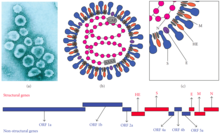Embecovirus
Embecovirus is a subgenus of coronaviruses in the genus Betacoronavirus.[1] The viruses in this subgenus, unlike other coronaviruses, have a hemagglutinin esterase (HE) gene.[2] The viruses in the subgenus were previously known as group 2a coronaviruses.[3][4]
| Embecovirus | |
|---|---|
 | |
| Murine coronavirus (MHV) virion electron micrograph, schematic structure, and genome. | |
| Virus classification | |
| (unranked): | Virus |
| Realm: | Riboviria |
| Kingdom: | Orthornavirae |
| Phylum: | Pisuviricota |
| Class: | Pisoniviricetes |
| Order: | Nidovirales |
| Family: | Coronaviridae |
| Genus: | Betacoronavirus |
| Subgenus: | Embecovirus |
| Type species | |
| Murine coronavirus | |
| Species[1] | |
| |
Structure
The viruses of this subgenus, like other coronaviruses, have a lipid bilayer envelope in which the membrane (M), envelope (E) and spike (S) structural proteins are anchored.[5] Unlike other coronaviruses, viruses in this subgenus also have an additional shorter spike-like structural protein called hemagglutinin esterase (HE).[2][6]
Recombination
Genetic recombination can occur when two or more viral genomes are present in the same host cell. The dromedary camel beta-coronavirus (Beta-CoV HKU23) exhibits genetic diversity in the African camel population.[7] Contributing to this diversity are several recombination events that had taken place in the past between closely related Beta-CoVs of the subgenus Embecovirus.[7]
See also
- Sarbecovirus (group 2b)
- Merbecovirus (group 2c)
- Nobecovirus (group 2d)
References
- "Virus Taxonomy: 2018 Release" (html). International Committee on Taxonomy of Viruses (ICTV). October 2018. Archived from the original on 4 March 2018. Retrieved 24 January 2019.
- Woo, Patrick C. Y.; Huang, Yi; Lau, Susanna K. P.; Yuen, Kwok-Yung (2010-08-24). "Coronavirus Genomics and Bioinformatics Analysis". Viruses. 2 (8): 1804–1820. doi:10.3390/v2081803. ISSN 1999-4915. PMC 3185738. PMID 21994708.
In all members of Betacoronavirus subgroup A, a haemagglutinin esterase (HE) gene, which encodes a glycoprotein with neuraminate O-acetyl-esterase activity and the active site FGDS, is present downstream to ORF1ab and upstream to S gene (Figure 1).
- Woo, Patrick C. Y.; Wang, Ming; Lau, Susanna K. P.; Xu, Huifang; Poon, Rosana W. S.; Guo, Rongtong; Wong, Beatrice H. L.; Gao, Kai; Tsoi, Hoi-wah; Huang, Yi; Li, Kenneth S. M. (February 2007). "Comparative Analysis of Twelve Genomes of Three Novel Group 2c and Group 2d Coronaviruses Reveals Unique Group and Subgroup Features". Journal of Virology. 81 (4): 1574–1585. doi:10.1128/JVI.02182-06. ISSN 0022-538X. PMC 1797546. PMID 17121802.
See figure 2.
- Wong, Antonio C. P.; Li, Xin; Lau, Susanna K. P.; Woo, Patrick C. Y. (2019-02-20). "Global Epidemiology of Bat Coronaviruses". Viruses. 11 (2): 174. doi:10.3390/v11020174. ISSN 1999-4915. PMC 6409556. PMID 30791586.
CoVs are classified into four genera, Alphacoronavirus, Betacoronavirus, Gammacoronavirus and Deltacoronavirus. Within Betacoronavirus, they can be further subclassified into lineages A, B, C and D [1]. In 2018, these four lineages were reclassified as subgenera of Betacoronavirus, and renamed as Embecovirus (previous lineage A), Sarbecovirus (previous lineage B), Merbecovirus (previous lineage C) and Nobecovirus (previous lineage D) [2]. In addition, a fifth subgenus, Hibecovirus, was also included (Figure 1) [2].
- Lai, Michael M. C.; Cavanagh, David (1997-01-01), Maramorosch, Karl; Murphy, Frederick A.; Shatkin, Aaron J. (eds.), "The Molecular Biology of Coronaviruses; III. Structure of Virions; A. Virion Morphology", Advances in Virus Research, Academic Press, 48, pp. 5–6, retrieved 2020-02-28
- Woo, Patrick C. Y.; Huang, Yi; Lau, Susanna K. P.; Yuen, Kwok-Yung (2010-08-24). "Coronavirus Genomics and Bioinformatics Analysis". Viruses. 2 (8): 1804–1820. doi:10.3390/v2081803. ISSN 1999-4915. PMC 3185738. PMID 21994708.
The presence of HE genes exclusively in members of Betacoronavirus subgroup A, but not members of Betacoronavirus subgroup B, C and D suggested that the recombination had probably occurred in the ancestor of members of Betacoronavirus subgroup A, after diverging from the ancestor of other subgroups of Betacoronavirus.
- Diversity of Dromedary Camel Coronavirus HKU23 in African Camels Revealed Multiple Recombination Events among Closely Related Betacoronaviruses of the Subgenus Embecovirus. So RTY, et al. J Virol. 2019. PMID: 31534035